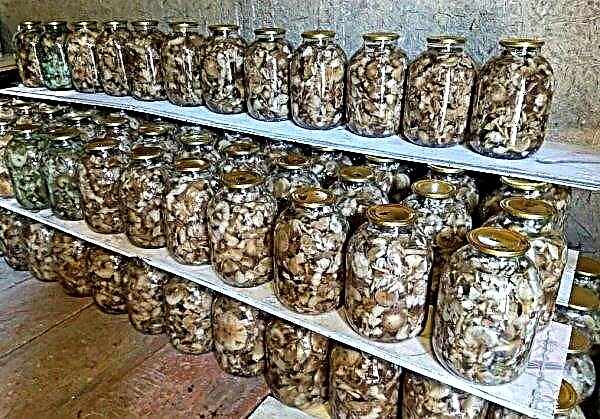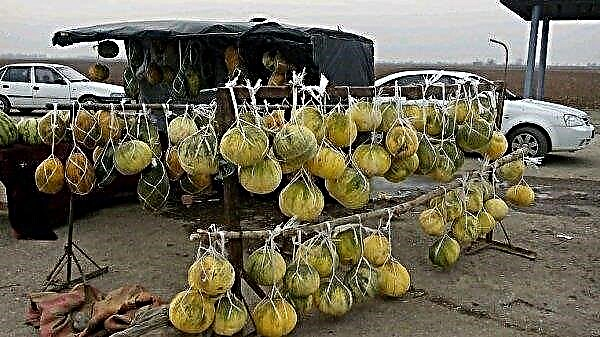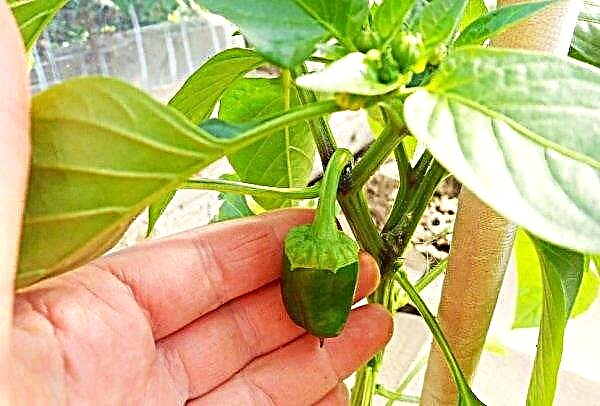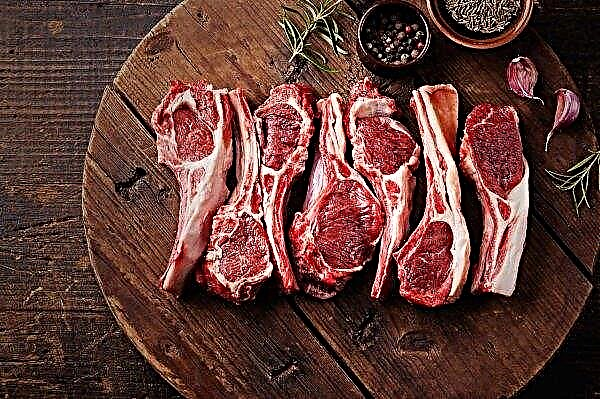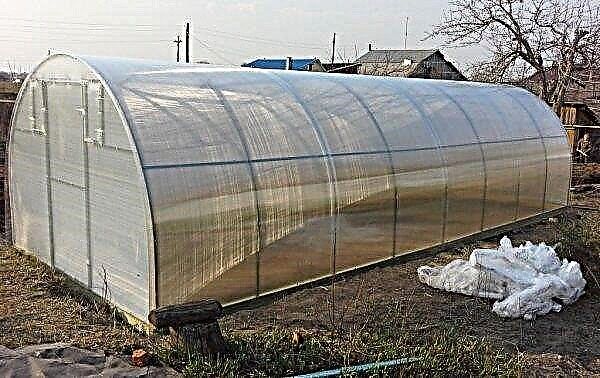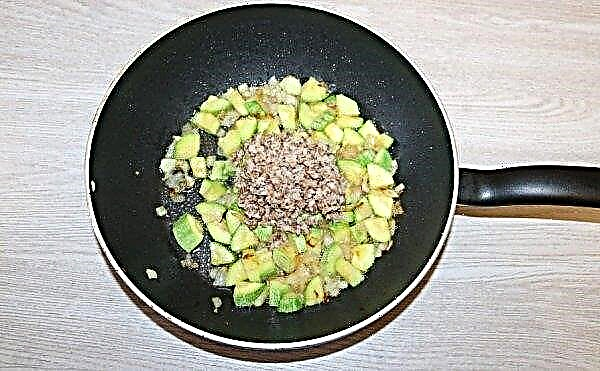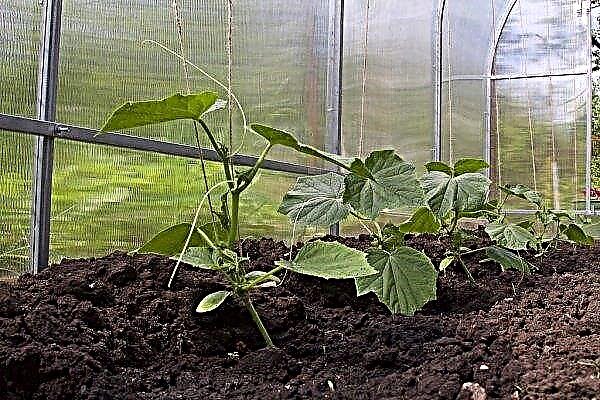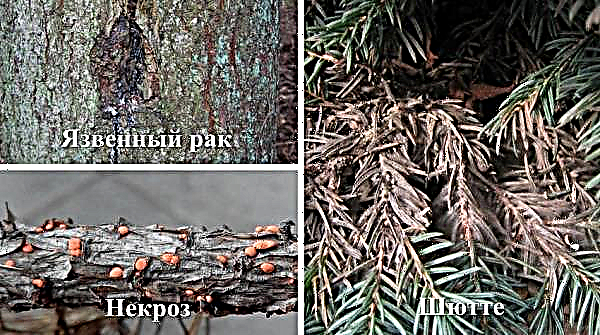Hybrid varieties, which breeders specially display more improved and more unpretentious, are becoming increasingly popular among gardeners. These include the tomato Red Arrow F1. Below will be considered in more detail the properties and features of this variety.
Biological Description of the Variety
The red arrow F1 is considered an early ripe variety of tomatoes grown in greenhouses or open ground. Develops bushes up to 120 cm high, with a small number of leaves of dark green color. On one plant, 10 to 12 hands are formed. On each brush 7–9 fruits are formed. Tomatoes have a rounded slightly elongated shape, bright red in color, with a dense skin. The pulp is juicy, fleshy, pleasant in taste, practically without seeds. The weight of one vegetable on average reaches 70-100 g.

Advantages and disadvantages
- The positive qualities of this variety include:
- unpretentious to the circumstances of cultivation;
- withstands temperature differences;
- high productivity (4 kg from 1 bush);
- good presentation, the fruits do not burst;
- universal use;
- long stored and tolerates transportation;
- resistant to major diseases;
- not picky about leaving, no need to stepchild.
The disadvantage is the need to tie the bushes to the support.
Self-growing seedlings at home
You can buy ready-made seedlings of this variety, or you can grow it yourself at home, following the main recommendations.
Important! A characteristic feature of the tomato Red Arrow F1 is that the fruits on the bush can be stored for 1 month without spoiling.
Sowing dates
Gardeners advise sowing seeds in the second half of March, about 2–2.5 months before planting seedlings in the garden.
The soil
The soil for sowing seed material can be purchased at a specialized store, or you can prepare it yourself in advance. To do this, mix peat, land from the garden, humus (or compost) and sand in a ratio of 2: 1: 1: 0.5. Also put 1 cup of wood ash, 3-4 tbsp. On a bucket of the obtained soil mixture. tablespoons of dolomite flour, 10 g of urea, 30–40 g of superphosphate, 10–15 g of potassium fertilizer. Disinfect with the help of drugs "Fitosporin" (5 g per 10 l of water), "Gamair" (1 tablet per 10 l of water), "Extrasol" 0.1% solution, etc.
Video: Tomato Red Arrow F1
Capacity for growing
You can sow seeds in different containers, taking into account their positive and negative qualities.
To do this, use:
- crates - can be made of wood, plastic or polystyrene, with a drainage bottom, 8-10 cm high. They are handy in operation, do not require large financial investments. But during planting seedlings in open ground, you can harm the roots of plants by pulling them out of the tank;
- individual cups - with a capacity of 100-200 ml with drainage. Inexpensive, small-sized, reusable, seedlings when planting in the soil are not injured. But they have thin walls, which under severe pressure can be deformed, damaging the roots of plants, and also they need to be tinkered with longer when carried or transported;
- peat tablets - Small washers from pressed peat containing the necessary nutritional components. Easily transplanted into open ground with the plant, nourish and strengthen the roots of seedlings. But tablets are single-use, they are more expensive than all, peat must be constantly moistened.
Did you know? In 1776, they tried to poison the future president of the United States of America, George Washington, with the help of tomatoes, considering them poisonous plants.
Seed preparation
Particular attention must be paid to the preparation of seed, which is as follows:
- first, the seeds must be disinfected in a 1% potassium permanganate solution for up to 30 minutes;
- soak for better growth according to the instructions in the Epin nutrient solution (1-2 drops per 100 ml of water), Immunocytophyte (1 tablet per 15 g of water) or in potato juice, etc .;
- germinate after standing in a damp tissue for 2-3 days;
- Temper by first placing in the refrigerator for 18-19 hours, then for 5 hours near the battery.
Sowing seeds
After the seeds have undergone the necessary processing and preparation, they can be sown in prepared containers.
To do this, you need:
- make small furrows in the ground 1 cm deep in the ground;
- sow seed 2 cm apart;
- if in separate cups or peat tablets, then put 2 pieces;
- sprinkle with soil mixture on top and moisten from a spray bottle;
- cover the containers with transparent glass or plastic film;
- hide in a warm place before germination.
Seedling Care
Further seedling care is as follows:
- when the first shoots appear, containers with seedlings must be opened and moved to a well-lit place, for example, on the windowsill;
- when 2 leaves are formed on the seedlings, they can be planted from boxes in a separate container;
- plants need to provide good lighting for 12-15 hours, if necessary, additionally use lamps;
- air temperature should be about + 18 ° C;
- watering should be regular and moderate, not allowing the soil to dry out;
- after 10-14 days, carry out the first basal fertilizer with a universal remedy for seedlings, carry out the following dressings with an interval of 2-3 weeks.
Important! In poor lighting, the seedlings will be very elongated.
Seedling hardening
7-10 days before transplanting seedlings in open ground, it is hardened, which provides better survival of plants.
It consists in the following:
- containers with seedlings are taken out to fresh air for 15–20 minutes when the temperature in the street heats up to + 15 ° С;
- each subsequent day the period of stay of seedlings increases;
- after 7 days she is left for the whole day;
- the day before planting, seedlings are outside the whole day.

Planting seedlings in a permanent place
Planting tomato seedlings The red arrow F1 falls on the first half of June, when 5-7 leaves appear on them, and consists of the following actions:
- 6 bushes per 1 m² are recommended;
- the distance between plants should be 50–60 cm, between rows 80–90 cm;
- the place is chosen quiet, protected from wind and drafts, maybe a little shaded.
Features of outdoor care
After the seedlings are planted in a permanent place and take root, it is necessary to provide constant care, consisting in timely watering, top dressing, tying the bushes to the supports, treatment from pests.
Watering
Water the plants regularly and make sure that the earth does not dry out, which can lead to loss of crop. It is better to use watering under the root in order to avoid the occurrence of late blight. On hot days, experts advise to irrigate the bushes in the evening, which will prevent them from burning out in the sun and provide better absorption of moisture into the ground.
Top dressing
Almost along with watering, it is necessary to fertilize the seedlings.
It is carried out in several stages, namely:
- the first top dressing is done 10–14 days after planting in open ground using mineral fertilizers (50–60 g of superphosphate, 30–50 g of urea, 30–40 g of ammonium sulfate, 20–25 g of potassium salt per 10 l of water), 0 each , 5 liters for each bush;
- the second feeding takes place after 3 weeks (80 g of double superphosphate, 3 g of urea, 50 g of potassium salt and 300 g of wood ash per 10 l of water) into a hole made at a distance of 15 cm around the tomato;
- the next top dressing is carried out during the ripening of the fruit with organic fertilizers (1 teaspoon of yeast, 1 teaspoon of sugar in 1 liter of warm water, later add another 5 liters of water).
Did you know? Earlier in France, in order to confess their love, they gave a tomato, because it was called there «apple of love».
Shaping and garter bush
Since this tomato variety forms high bushes and gives a large crop, they must be formed and tied to a support. With the help of a garter, the plant branches will not break, the fruits will ripen better and not spoil, it will be easier to take care of the tomatoes during weeding and loosening of the soil.
To do this, you must:
- near each bush install a wooden stake or a metal, plastic pipe up to 1.5 m high above ground level;
- tie a tight trunk to the support with a rope or strips of fabric, so as not to damage the plant;
- as the tomatoes grow, tie them several more times.

Soil care
Soil care consists in constantly weeding a bed of weeds. After each watering or rain, the earth is loosened and spudded, thereby providing plant roots with oxygen and for preventing the occurrence of fungal diseases. Also, to retain moisture, it is advisable to mulch the soil around the stems with dry grass, straw, sawdust or compost.
Pest and Disease Control
Tomato Red Arrow F1 is a hybrid, so it is not susceptible to major diseases. His main enemies include Colorado potato beetle, spider mite, aphidwhich can be destroyed with insecticides, such as Actellik (2 ml per 2 l of water), Proteus (7 ml per 5 l of water), Fufanon (10 ml per 10 l of water), etc.
Important! The use of insecticides is necessary, strictly adhering to the appropriate instructions.
Harvest dates and features
Harvesting this variety occurs in late July - early August. A feature is considered to be that the fruits ripen almost simultaneously and the bushes bear fruit for a long time. From 1 m², you can collect up to 24 kg of tomato.
Tomato Red Arrow F1, due to its positive qualities, increasingly began to appear on the beds at gardeners and on tables at housewives.




